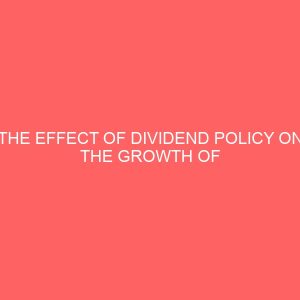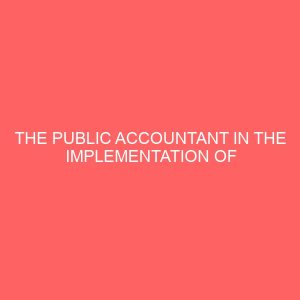Description
THIS RESEARCH IS ON THE EFFECT OF DIVIDEND POLICY ON THE GROWTH OF MICRO FINANCE INSTITUTION
CHAPTER 1: Introduction
Micro-finance refers to financial services such as cash loans, deposit savings accounts, and insurance made available in relatively small amounts to poorer populations throughout the developing world. Microfinance basically relates to all financial intermediation services such as savings, credit, funds transfers, insurance, pension and remittances among others by financial institution in both rural and urban areas to low income earners (Robinson, 2001). Microfinance promises both to combat poverty and to develop the institutional capacity of financial systems, through finding ways to cost-effectively lend money to poor households (Morduch, 2000). Three features distinguished microfinance from other formal financial products: the smallness of loans offered or savings collected the absence of asset-based collateral and the simplicity of operations (Seyed, 2011) . Loan repayment which measured portfolio quality was an essential ingredient for sustainability of MFIs. Loan repayment indicators included Portfolio at risk (PAR), credit risk measured by the sum of the level of loans past due 30 days or more (PAR>30) is negatively and significantly related to MFI sustainability (Cooper, A. Jackson, M. J . Patterson, G. A., 2003). Increased exposure to credit risk resulted to lower MFI sustainability, given that credit granting was the principal source of revenue for these institutions. There was a positive influence of
the collection of deposits from clients in form of savings and also shares. Microfinance is primarily a cash-based operation and involves member’s savings. However, to make the sorts of investment that stimulate endogenous economic growth, one needs access to financial capital that comes either from savings or from borrowing, which is difficult in environments where the formal means of either saving or borrowing are typically absent. Traditional communities had informal mechanisms for savings. For example, voluntary rotating savings and credit associations of various sorts are proliferating across Southeast Asia and Africa allowed individuals to receive periodic payouts from group contributions (Anthony, 2005).
1.1 Background of the Study
Dividend policy is the regulations and guidelines that a company uses to decide to make dividend payments to shareholders (Nissim & Ziv, 2001). Dividend, which is basically the benefit of shareholders in return for their risk and investment, is determined by different factors in an organization. Firms ought to distribute their earnings to shareholders if they cannot identify suitable investments which would bring higher returns than those expected by the shareholders Mizuno (2007) .Dividend policy also affected MFI performance in that it encouraged members to increase their deposits because in the end of the year the profits arising from the performance was shared in form of dividend. The more the savings the more dividends received. Dividend policy is the decision to pay out earnings versus retaining and reinvesting them. Dividend policy was considered to be one of the most important financial decisions that corporate managers encounter (Baker & Powell, 1999). It had potential implications for share prices and hence returns to investors, the financing of internal growth and the equity base through retentions together with its gearing and leverage (Omran & Pointon, 2004). The research seeks to investigate the effect of dividend policy on the growth of microfinance institutions.
1.2 Statement of the Problem
Dividend policy is the regulations and guidelines that a company uses to decide to make dividend payments to shareholders (Nissim & Ziv, 2001). Dividend, which is basically the benefit of shareholders in return for their risk and investment, is determined by different factors in an organization. Firms ought to distribute their earnings to shareholders if they cannot identify suitable investments which would bring higher returns than those expected by the shareholders Mizuno (2007). The amount of dividends is distributed to shareholders or members in cash. These distributions should be made from Retained Earnings. The main goal of every Microfinance Institution (MFI) is to operate profitably in order to maintain its stability and improve growth and sustainability. But this often affected by the real factor condition under which the firm operates, when there is uncertainty of earnings, unsuccessful business operations, lack of liquid resources, and fear of adverse effects of regular dividend on the financial standing of the company a policy of irregular dividends is adopted where earnings are unstable and management considers that shareholders are entitled to dividend only when the earning and liquidity positions of the banks warrant it. The larger the earning higher the dividend and vice versa .According Moh’d, Perry, and Rimbey (1995) firms with unstable earnings








Reviews
There are no reviews yet.